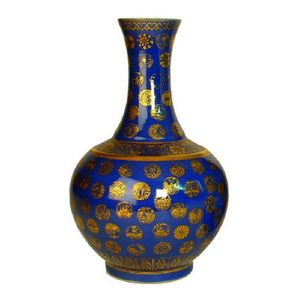Twin Handled Faux Bronze Vase with Seal Mark
You must be a subscriber, and be logged in to view price and dealer details.
Subscribe Now to view actual auction price for this item
When you subscribe, you have the option of setting the currency in which to display prices to $Au, $US, $NZ or Stg.
- Bronze - An alloy of copper and tin, traditionally in the proportions of about 9 parts of copper to 1 part of tin.
The discovery of bronze in Western Asia in the 4th century enabled people to create metal objects which were superior to those previoulsy possible because of its strength and hardness, and it has been used throughout the world for weapons, coins, tools, statuary and other decorative items.
It is very fluid in a molten state, and its hardness, strength when set, and non-corrosive properties makes it most suitable for casting sculpture. - Faceting - Faceting is a technique of removing material from a curved surface, to give a series of flat surfaces but retaining the profile of the original surface.
The technique is most commonly associated with diamond cutting where the various cuts used such as rose cut and brilliant cut, add life and sparkle to the stone, whilst at the same time removing as little of the stone as possible.
Faceting by grinding is also used to decorate glass. The stems of many drinking glasses are decorated by cutting a series of flat surfaces on a circular stem, and hollow vessels such as vases may have faceted surfaces.
In furniture faceting is often applied to legs of tables and chairs, where a circular baluster shaped section is flattened so as to form an octagonal section. - Faux - A French word meaning "false", but when used in decorative arts, the intention is not to deceive, but to simulate the decorative effects of the more expensive material it is imitating. The term " faux bois" meaning "false wood" refers to a furniture item that has been decorated with a marked grain (woodgrain finish) to imitate a more expensive timber.
This item has been included into following indexes:
-
oriental objects
- bronze vases, Chinese 141
- bronze, other objects 2,529
Visually similar items

A Chinese blue and white bottle vase possibly, 18th/19th century together with an ebonised stand, the vase, 24 cm high

A Bristol blue glass jug, the cushion profile jug with an applied clear rope twist handle and a star burst to the base . Height 18 cm

A sterling silver mounted and cut crystal claret jug, hallmarked sterling. Height 29 cm.

A Chinese large porcelain vase, baluster shape with powder blue glaze and a pattern of various gilt circular motifs, stylised friezes decorate the rim, shoulder and foot, six character Qianlong mark under the base. Height 39 cm
